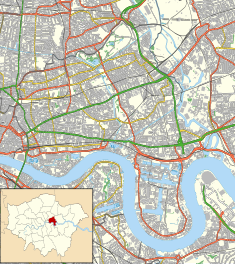| Poplar Town Hall | |
|---|---|
 The building in 2007 | |
| Location | Bow Road, Poplar |
| Coordinates | 51°31′42″N 0°01′11″W / 51.5284°N 0.0198°W |
| Built | 1938 |
| Architect | Culpin and Son |
| Architectural style(s) | Modernist style |
Listed Building – Grade II | |
| Designated | 24 February 2009 |
| Reference no. | 1393151 |
Poplar Town Hall is a municipal building at the corner of Bow Road and Fairfield Road in Poplar, London. It is a Grade II listed building.[1]
History
[edit]The building was commissioned to replace the Old Town Hall, located 1.7 miles (2.7 km) due south on Poplar High Street.[2][3] The site chosen for the new building had been occupied by a 19th century vestry hall.[4]
The foundation stone for the new building was laid by the former mayor, Alderman Charles Key, on 8 May 1937.[5][6] It was designed by Culpin and Son in the Modernist style in a shape that took the form of a trapezoid.[1][7] The design involved a rounded frontage at the junction of Bow Road and Fairfield Road; there were layers of continuous stone facing panels above and below a continuous band of glazing on the first, second and third floors.[4] The Builders, a frieze by sculptor David Evans on the face of the building, was unveiled by George Lansbury at the official opening of the building on 10 December 1938.[1] Made of Portland stone panels, it commemorated the trades constructing the town hall and symbolised the borough's relationship with the River Thames and the youth of Poplar.[8][9] The principal rooms were the council chamber, the mayor's parlour and an assembly hall which benefited from a sprung Canadian maple dance floor.[10] The architect, Edwin Culpin, claimed it was "the first town hall in this country to be erected in the modern style".[11]
The building was proclaimed by the council to be the first town hall to be erected in the modernist style[4] but ceased to function as the local seat of government when the enlarged London Borough of Tower Hamlets was formed in 1965.[12]
After being used as workspace by the council until the mid-1980s, the town hall was sold in the 1990s to a developer who added a roof extension and converted it for commercial use.[10] The complex had included a theatre, with a 35 feet (11 m) proscenium arch, which was demolished by the developer in 2000.[13] The complex was subsequently used as a business centre.[4]
References
[edit]- ^ a b c Historic England. "Former Poplar Town Hall (Bow House), 157 Bow Road (1393151)". National Heritage List for England. Retrieved 15 May 2020.
- ^ Historic England. "Old Poplar Town Hall and Council Offices (1260135)". National Heritage List for England. Retrieved 15 May 2020.
- ^ "Old Poplar Town Hall". London Remembers. Archived from the original on 13 August 2022. Retrieved 15 May 2020.
- ^ a b c d Smith, Joanna (1998). "Greater London | Tower Hamlets | Bow Road | Bow House (Formerly Poplar Town Hall) (1993-08-03)". London's Town Halls (PDF) (Report). 93/1998. Historic England. pp. 180–181. Retrieved 5 August 2024.
- ^ Boardman, David. "Bow House - Former Poplar Town Hall, London". manchesterhistory.net. Retrieved 25 April 2020.
- ^ "Poplar Town Hall – foundation". London Remembers. Retrieved 5 August 2024.
- ^ "Poplar Town Hall, Bow Road: under construction". London Picture Archive. Retrieved 5 August 2024.
- ^ "The Builders: Architect". Public Monuments and Sculpture Association. Archived from the original on 16 July 2011. Retrieved 1 April 2007.
- ^ "Carved relief, former Poplar Town Hall, Bow Road, Poplar, London". Historic England. Retrieved 5 August 2024.
- ^ a b East, John; Rutt, Nicola, eds. (24 March 2012). "The Civic Plunge Revisited" (PDF). The Twentieth Century Society. pp. 27–28. Retrieved 25 April 2020.
- ^ "Poplar Town Hall – 1930s". London Remembers. Retrieved 5 August 2024.
- ^ "Local Government Act 1963". Legislation.gov.uk. Retrieved 25 April 2020.
- ^ "Bow". Theatres Trust. Retrieved 5 August 2024.

Well, that’s interesting to know that Psilotum nudum are known as whisk ferns. Psilotum nudum is the commoner species of the two. While the P. flaccidum is a rare species and is found in the tropical islands. Both the species are usually epiphytic in habit and grow upon tree ferns. These species may also be terrestrial and grow in humus or in the crevices of the rocks.
View the detailed Guide of Psilotum nudum: Detailed Study Of Psilotum Nudum (Whisk Fern), Classification, Anatomy, Reproduction